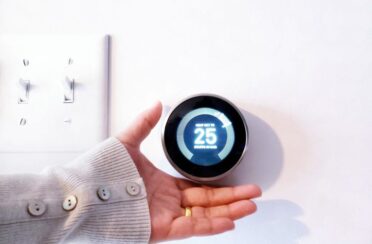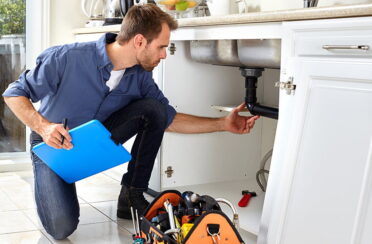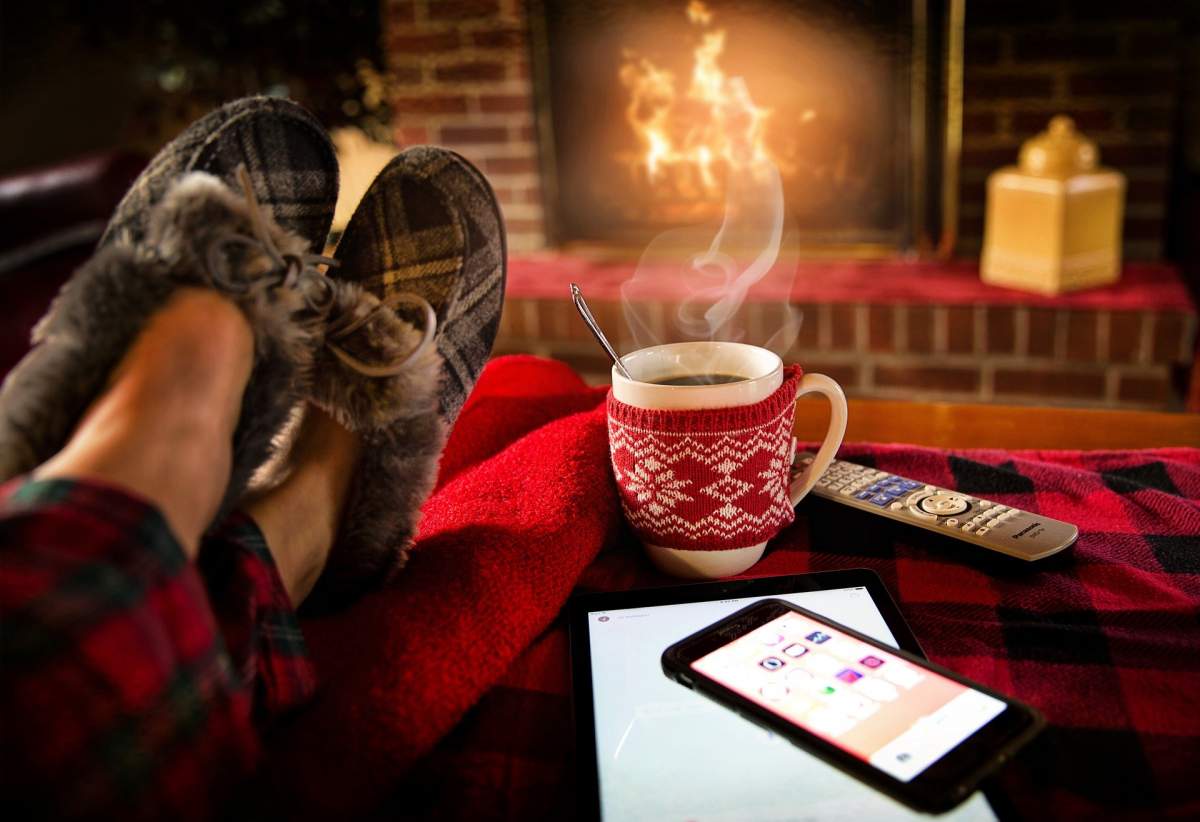 ‘Tis the season for a cozy fire, a classic Christmas movie and a big mug of hot chocolate (with extra marshmallows, of course). It’s also the season to prep your home for winter weather as Calgary’s snowy season is upon us. We’ve put together a list, and we’ve checked it twice, that you can use to prepare your home for colder weather.
‘Tis the season for a cozy fire, a classic Christmas movie and a big mug of hot chocolate (with extra marshmallows, of course). It’s also the season to prep your home for winter weather as Calgary’s snowy season is upon us. We’ve put together a list, and we’ve checked it twice, that you can use to prepare your home for colder weather.
In this guide we will cover the following:
PLUMBING FURNACE BOILER INDOOR AIR QUALITY
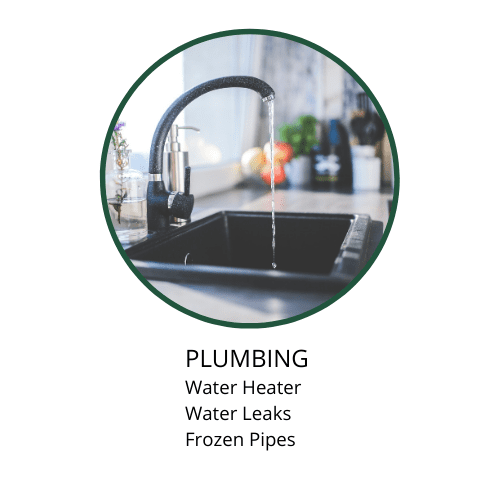 WINTER PLUMBING PREP
WINTER PLUMBING PREP
Winter brings colder weather and harsher conditions. Your home’s plumbing system is especially vulnerable to the cold and improper preparations can lead to expensive repair and inconvenience. A plumbing checkup every fall keeps your home safe for the winter. Proper preparation keeps your plumbing system working efficiently no matter what the weather may bring.
There are several different parts of your plumbing system that have to be evaluated to ensure they are ready for the winter months. Get your clipboard ready and let’s get to it!
Water Heater Maintenance in the Winter
Does it seem as if your water heater doesn’t deliver water as hot as it should be in the winter? In Calgary, that’s pretty important, particularly if your home has multiple occupants and there’s the possibility of running out of hot water before everyone has had a shower.
Let’s have a look at the several reasons your water heater may be running short of hot water, or not producing water as hot as you’d like it.
Flush the Water Heater
Sediments collect in your water heater with the water from the underground pipes, and over time, sediment can build up and make it difficult for the heating element to do its job. It’s a good idea to get the tank flushed every now and then. A sign of sediment buildup is a popping or knocking noise.This not only makes your water heater more efficient it can also increase its lifespan as sediment build-up leads to corrosion. Read your manual to determine how often your water heater should be flushed.
Check the Thermostat Setting
Your water heater may be located in a cold space, such as a garage or basement, where it is more of a challenge to heat water in the winter. You may need to turn the thermostat up 10 to 15 degrees.
Aging Water Heater
If your water heater is aging and is 10 years old or more, it may be wearing out and time to consider a replacement. In the meantime, you can try raising the temperature in the room where the tank is located by sealing air leaks or turning up the heating.
Faulty Dip Tube
The dip tube is a plastic pipe that deposits cold water as it enters the tank at the bottom, where it is heated by the heating element. If the tube breaks, it may deposit cold water in the upper levels of the tank, where the heated water sits before it is sent to the faucets. The intermingling of the cold water with the heated water makes it lukewarm on delivery.
Pipe Insulation
One of the most common plumbing issues that homes encounter during the winter is a lack of insulation around the pipes. This can cause pipes to become frozen leading to expensive repairs, damage, and make daily living highly frustrating due to a lack of water.
How to Prevent Frozen Pipes
Frozen pipes are one of the most common plumbing issues that occur during the colder months of the year. Frozen pipes are not only an inconvenience, they can also be a large repair project in worst-case scenarios. The following frozen-pipe-prevention tips help keep your pipes safe from the cold.
Water Leaks
Water leaks can happen because of freezing weather and you may end up with mould leading to huge repair costs. Fortunately, there are many devices that can help prevent water leaks including main water shut offs and water leak detection systems. If you have questions about options our certified technicians can help you find the best solution for your home.
Install an Insulated Cover on Outdoor Faucets
To avoid the mess and damage caused by frozen, ruptured water pipes, shut off and drain the line to your outdoor faucet in the fall, then install an insulated cover. To protect water lines running through uninsulated areas like the garage or attic, install foam pipe insulation sleeves or wrap the pipes with self-regulating electric heat tape.
Keep Your Home at the Right Temperature
One of the easiest ways to keep your pipes from freezing is to keep your house warm. A thermostat setting of 20°C or higher keeps your home not only comfortable but also protects pipes from freezing. Set your thermostat to cool down a bit at night to save on energy costs and warm up shortly before you get out of bed.
Don’t Turn the Heat Off When You’re Away
When you leave your home for an extended time, do not turn the heat off. Leaving the thermostat at 18°C or higher keeps the pipes safe when you’re away.
Circulate Warm Air
The pipes under your sinks are often lacking in insulation. By opening your kitchen (and bathroom) cabinets, you can keep your pipes warm by allowing in the warm air that’s already circulating throughout your home.
Avoid Drafts
An easy way to prevent frozen pipes is to limit drafts. This can include keeping side doors and garage doors closed and also checking your pipes for the proper amount of insulation in areas such as your basement or attic.
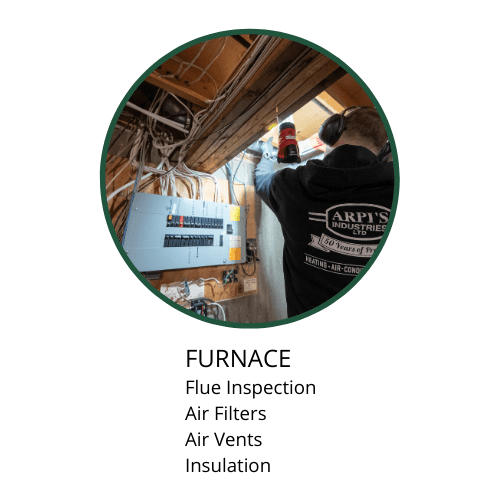 HOW TO PREP YOUR FURNACE FOR WINTER
HOW TO PREP YOUR FURNACE FOR WINTER
Our winter weather in Calgary requires the heart of our home heating system to be in top health. Whether you have a furnace or a boiler, check out these winter maintenance tips to keep your home warm and toasty through frosty Calgary winters.
Tidy Up Around the Furnace
Clear away any stored items from around the furnace that are flammable or might restrict airflow, and move any combustibles like charcoal lighter fluid, paint thinner, and aerosol cans to a ventilated area well away from the furnace.
Have the Chimney Flue Inspected and Cleaned
Hire a professional to inspect the flue or chimney for obstructions and sweep out any accumulated soot and debris so that hazardous furnace combustion fumes can vent properly.
Schedule Heating System Maintenance
Have an experienced HVAC pro inspect, clean and tune up your heating system to ensure it’s operating safely and reliably this winter. Some of the safety-related tasks a technician performs include checking the integrity of the heat exchanger, cleaning and adjusting the burner, testing the system’s safety controls, inspecting the wiring, and tightening the electrical connections. Another very important part of a proper tune-up is performing a combustion analysis. The combustion analysis allows for a very unique, in depth look at how efficiently the furnace is burning fuel.
Change Your Air Filter More Often in Winter
With the furnace operating nearly 24/7 this time of year, many homeowners are prone to taking their heating system for granted, especially if they scheduled pre-season maintenance on the furnace before the weather turned cold in the fall. Yet, there’s one furnace maintenance task that you won’t want to skimp on this winter – change your air filter regularly. Find out what kind of filtration you have in your house to determine how often to change the filter based on the manufacturer’s recommendations.
The air filter requires more frequent checking and changing in the winter for a simple reason: the furnace is in operation more than any other time. The more air that circulates through a forced-air heating system, the more airborne particulates get removed by the filter. Hence, the filter gets clogged much sooner.
A clogged furnace filter can have several negative impacts on your heating system and the service you expect from it. If you don’t change your air filter frequently enough in the winter, it can fill up with dust, debris, pet dander and pollen. A dirty air filter can restrict air flow impacting even heating throughout the house and the furnace will struggle to deliver enough conditioned air to satisfy the thermostat setting. The furnace has to work harder, which stresses the blower motor, and may lead to more frequent breakdowns resulting in wasted energy, higher heating bills and poor indoor air quality.
Open and Clean Air Vents
During the winter we use our heating system a lot, so the vents may become clogged with dirt and other debris. Air vents where heated air enters your home should be opened and cleaned. Remove accumulations of dirt, dust, lint, fuzz, or anything else that could be dislodged by airflow and blown into your home. Check them regularly, vacuuming and cleaning grilles. Make sure the dampers to ducts are open so the air can flow freely.
Seal Air Leaks & Add Insulation
One of the best ways to lower your energy bill is to ensure that heated air stays inside your home, and cold air doesn’t get inside. You can hire a professional to do an energy loss inspection in your home, or you can do an informal check by passing a lighted incense stick in front of windows, doors or any opening to the exterior of the home and look to see if the smoke is disturbed. Add insulation, weatherstripping and caulk as needed. Be sure to check the insulation levels on the floor of the attic. Insulation should be at least up to, or over the joists.
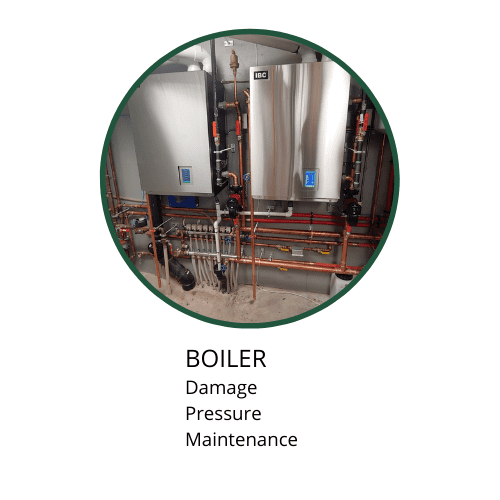 BOILER MAINTENANCE FOR WINTER WEATHER
BOILER MAINTENANCE FOR WINTER WEATHER
A boiler can be a wonderful way to heat your home and there are several factors to consider when deciding between a boiler and a furnace. If you have a boiler there can often be maintenance upkeep that requires a technician to perform and it’s important to check the following items to ensure your boiler is ready for colder days.
Check For Cracks or Damage to Your Boiler
Look at your boiler to see if there are any cracks or obvious signs of damage on the outside. Use a flashlight if you need to. These signs of wear and tear indicate that your boiler may need some repairs, or in some cases, may need to be replaced entirely. A cracked boiler is dangerous and shouldn’t be operated in your home.
Check the Boiler Pressure
Check the boiler pressure. Most boilers have a pressure gauge manual. Pressure too high or low requires professional maintenance as soon as possible.
Keep the Area Around the Boiler Clean
Make sure nothing has moved closer to the boiler like debris or items from your basement. Things like furniture, paperwork, leaves, clothing or holiday supplies can be a fire hazard if they are too close to your boiler. Clean the area around your boiler and make sure all items are as far away as possible.
Schedule Annual Maintenance on Your Boiler
Get your boiler serviced before it gets too late in the fall. An annual service, even if there was nothing wrong with your boiler the last time you used it, can help to keep small problems from turning into big ones. That can save you money and make sure your boiler functions the right way when you need it to on cold winter nights.
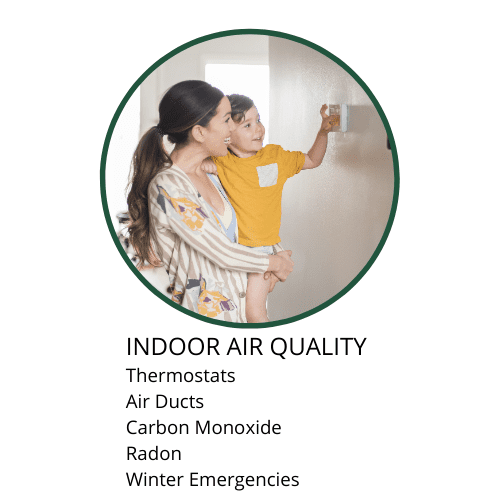 HOME COMFORT & INDOOR AIR QUALITY
HOME COMFORT & INDOOR AIR QUALITY
There is nothing worse than waking up in the middle of the night to plummeting temperatures because your thermostat batteries died and your furnace shut off. Schedule regular checks into your phone to keep up small maintenance tasks to make sure devices are in good working order. Making sure these are done as the weather starts to get colder can ensure a more comfortable cozy atmosphere at home all winter long.
Check and Test Thermostat
The thermostat controls your heating system, so it needs to be in good working order. Test the thermostat to make sure it effectively turns your HVAC equipment on and off. If your thermostat has batteries you must check them annually and replace them if needed. If there are problems with the thermostat, replace it before heating season is fully underway.
How to Program a Thermostat for Winter
-
Choose a lower temperature setting when your family is asleep or away from the home. Some programmable thermostats have savings set points that identify the ideal temperatures for different times of the day. Use these to help identify where the thermostat should be set.
-
Use the manual override option sparingly. If you find yourself frequently changing the thermostat’s settings manually you likely need to adjust your permanent settings.
-
Avoid trying to heat (or cool) your house faster. Spiking the temperature to 32 degrees C won’t heat your house any faster just liking dropping it to 4 degrees C won’t make it cool any quicker. All this does is increase your energy costs and put unnecessary stress on your HVAC system.
-
Change the batteries (if necessary). If your programmable thermostat runs on batteries make sure you replace them on a regular basis. This will ensure your home stays comfortable and you get the most benefit out of the thermostat.
Duct Cleaning
We recommend you consider duct cleaning every 3 to 4 years. Keeping your ductwork clean improves the quality of the air you breathe.
Winter Emergency & Safety Checklist
When autumn weather is fading and winter is settling in, it’s wise to take precautions to avoid damage to your home and keep your family safe from hazards like carbon monoxide (CO) poisoning. Following these winter home safety tips can help you stay snug and secure during the cold months ahead.
Test Your Carbon Monoxide Detectors
***Carbon monoxide detectors do have a expiry date so make sure to test and replace when the device expires***
If you have a fuel-burning furnace, check the carbon monoxide detectors in your home. Carbon monoxide is a highly dangerous gas produced as a byproduct of combustion. It has no colour, odour, or taste, and if it leaks from your furnace, it can be fatal. Carbon monoxide detectors are therefore a critical element of home safety during heating season. To make sure these life saving devices are able to sound an alarm when needed, test them monthly, and if you haven’t done so in the past six months, replace the batteries. To ensure your safety, replace any device that doesn’t beep when tested.
If there is extreme snowfall, check the vents on all gas burning appliances. It’s good practice to check outside exhaust vents for any blockages year round.
Gas Appliance Maintenance & Combustion Analysis
Arpi’s performs a combustion analysis during the maintenance of any gas appliances like tankless water heaters, furnaces, and boilers. This can determine how much CO and CO2 are being produced and can eliminate unsafe conditions. If you are concerned about this and would like to schedule an inspection contact Arpi’s to set up an appointment.
Radon
Cold weather can increase radon levels in your home. Like carbon monoxide, radon is a colorless, odorless gas and has no taste. Radon gas occurs naturally in all soils and is the result of decaying uranium, radium, thorium as well as other radioactive elements present in all soils. Radon gas enters your home through cracks in the concrete floor or foundation as well as other openings such as sump pumps and floor drains.
Fall and winter are the best times to start a radon test as your heating system should be running while a test is being performed.
How to Prepare for a Winter Storm
Here in Calgary we have to take HVAC maintenance seriously. Even in a mild winter, an arctic cold front or a blizzard can blow in, making temperatures plummet, icing power lines and downing trees. There’s also the possibility your heating system can fail just when you need it most. That’s why it pays to stay on top of things.
If you find yourself without power due to a winter storm this season, you’ll be glad you have a winter storm emergency plan in place. The three main concerns during a power outage are having a safe food supply, water supply and heating source. Here are a few simple steps you can use to prepare:
Backup Food Supply
For longer power outages that last for days, you’ll need a way to keep perishable goods from spoiling. Store a few disposable coolers in your home, and have a backup supply of ice. Remove items from your fridge and store them in the ice-packed coolers. You can keep food in your fridge cold for a time, but avoid opening the door too much, as this will allow warmer air to access the fridge. Keep a supply of non-perishable food on hand and store a non-electric can opener nearby.
Extra Water Supply
It may seem like an odd concern to worry about water supply during a winter storm. But in an unlikely series of events you may find yourself with burst pipes in your home or a water main break on your street leaving you without water. Add a blizzard to the mix and the city might not have access to your street to bring a tank of emergency water for residents to access. If temperatures are well below freezing with a storm on the way, you’ll need to gather a supply of water. Gallon jugs will do for drinking water, and you can fill buckets or your bathtub for flushing toilets. Keep an eye out for conditions that can lead to your plumbing pipes freezing, which will not only leave you without water, but with a huge mess and costly damage on your hands.
Alternative Heating in Power Outage
If you have a wood-burning stove or fireplace, stock enough wood to last several days. Otherwise, you and your family will need to stay warm through other means. To stay warm, wear two layers of clothing, and keep a hat on to prevent heat loss. Wrap up in a cozy blanket. Gather the family in one room and close the doors. Your body heat should warm up the space a little bit.
Unless you have a generator to power your home, you’re smart to develop a winter storm emergency plan. While most Calgarians know to keep a car emergency kit in their vehicle, it’s just as important to have a home emergency kit prepared.
Additional Maintenance
The Gutter System
Your home’s gutter system also helps in the removal of water from your home’s roof. Gutters should be cleaned and checked every fall as blockages can cause water to collect during the winter leading to ice and ice dams which can damage your roof and other parts of your home.
Sump Pumps
A sump pump is a common part of many homes and is used to remove excess water and prevent damage to your home’s basement. Sump pumps should be checked for functionality and cleaned out.
Schedule Preventive Maintenance
Get in touch with your HVAC service provider and schedule a professional maintenance visit. This will allow an HVAC pro to inspect the system and make minor and repairs and adjustments that will keep it working properly.
